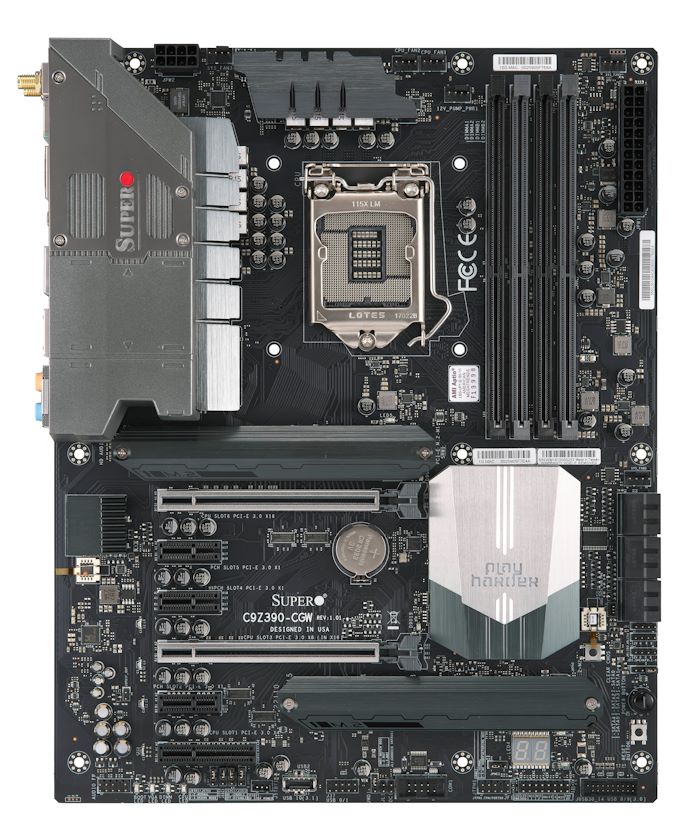Intel Z390 Motherboard Overview: 50+ Motherboards Analyzed
by Ian Cutress & Gavin Bonshor on October 8, 2018 10:53 AM EST- Posted in
- Motherboards
- Intel
- MSI
- Gigabyte
- ASRock
- EVGA
- Asus
- NZXT
- Supermicro
- Z390
Supermicro C9Z390-CGW
The SuperO C9Z390-CGW is an ATX sized model which is targeted towards gamers looking to utilize some of the more premium features as the PGW model, but with some obvious cutbacks. The C9Z390-CGW has two full-length PCIe 3.0 slots which operate at ether x16/x4 with the bottom PCIe 3.0 x4 slot populated at the bottom and/or x16/x8 and the bottom slot is disabled when the second full-slot is in use. bottom. Sandwiched in between the full-length slots are three PCIe 3.0 x1 slots with a pair of M.2 PCIe 3.0 x4 slots with heatsinks also among the PCI. Other storage options include six SATA ports with support for RAID 0, 1, 5 and 10 arrays. Memory support is slightly lower than the PGW with the CGW supporting up to DDR4-3866 and up to a maximum capacity of 64 GB across four available slots. Like the flagship PGW model featured above, the CGW also features five 4-pin fan headers with one of the headers being designated to water cooling pumps.
On the rear panel of the C9Z390-CGW are three USB 3.1 Gen2 Type-A ports with an additional Gen2 Type-C port and two USB 3.0 Type-A ports making up the rest of the USB connectors. A total of two LAN ports are present with one coming via an Aquantia AQC107 10G NIC with the other being controlled by an Intel I219V Gigabit chip. The five 3.5 mm audio jacks and S/PDIF optical out are powered by a Realtek ALC1220 HD audio codec and the board also includes a PS/2 combo port, two DisplayPort 1.2 outputs, a single HDMI 1.4 output and two antenna connectors for the included 802.11ac dual-band Wi-Fi adapter; this also provides users with Bluetooth 5 connectivity.
The Supermicro C9Z390-CGW takes certain elements of the flagship C9Z390-CGW such as 10G Aquantia networking, dual-band 802.11ac Wi-Fi connectivity with two full-length slots offering x16 bandwidth on both for unrestrictive bandwidth when running two-way CrossFire and SLI setups; it's quite likely the bottom PCIe 3.0 x4 shares bandwidth with the M.2 slots. The C9Z390-CGW slots right underneath the more comprehensive PGW, but as of yet initial pricing is currently unknown.












79 Comments
View All Comments
pawinda8 - Monday, October 15, 2018 - link
Still no mention of any Z390 boards with native Thunderbolt 3 (not AIC)! Has Intel given up on Thunderbolt for the PC world?gavbon - Monday, October 15, 2018 - link
If it's not integrated into the chipset, it's not really native as such. The ASRock Z390 Phantom Gaming-ITX/ac has a Thunderbolt 3 port on the rear panel, but that's the only one I'm afraidHikariWS - Monday, October 15, 2018 - link
Oculus Rift requires 3 USB3 ports and doesn't accept any of them being connected to a hub, they all need to be connected directly into a raw port. I had to buy a dedicated 3GIO USB 3 board that added 6 useful extra ports. In my (yes, old) Gigabyte z87 mobo I also had issues using keyboard and mouse on USB 3 ports inside UEFI and some recovery softwares, so I had to buy a USB 2 mirror to connect them.Because of that, having USB 2 ports on front panel and nice quantity of USB 3 is what most differs mobos for me, given that all other features are nearly the same.
ASUS Z390-A seems to be the best option. It has the important double USB2 ports, 5 USB3 ports and still has HDMI and DP for emergencies.
just4U - Monday, October 15, 2018 - link
I wish MSI had released a "godlike" board for the Ryzen series.ThugEsquire - Tuesday, October 16, 2018 - link
You list the ASRock Z390 Phantom Gaming-ITX/ac above as an ATX board, but it's actually mITX. FYIgavbon - Friday, October 19, 2018 - link
I have gone through every page where the Phantom Gaming-ITX/ac is listed, but I can't see where it says it's an ATX board? Could you please be more specific? Are you viewing on mobile or desktop?Galcobar - Tuesday, October 16, 2018 - link
It would be really helpful to break out one more criteria into a table: Type-C header for case-front ports.Helping a friend put together an i5 system and, knowing he'll keep it for a long time, am trying to get even with peripheral connectors (already has a monitor, so no using that as a hub). It's relatively easy to identify cases with a Type-C port, but that's pointless without a motherboard header. Having to go into each board's page to check is time-consuming.
jjnam - Thursday, April 18, 2019 - link
6 months later and I'm here for EXACTLY this reason. I've gone through probably 50 manuals over the past few days squinting to find this information. What a pain.Synomenon - Thursday, October 18, 2018 - link
So on the ASRock Z390 Phantom Gaming-ITX/ac, is the TB3 port on the rear using up lanes from CPU (making the only 16x slot, 8x only)?If it's not using lanes from the CPU, how will using that TB3 port (say with a USB3.1 Gen2 hub OR TB3 hub) affect all the other ports / IO on the board?
repoman27 - Thursday, October 18, 2018 - link
Going off of what TweakTown published, it's a single-port Intel JHL6240 "Alpine Ridge" controller with a PCI 3.0 x2 connection to the PCH. So it won't affect the PEG lanes from the CPU. I'm amazed it's not Titan Ridge at this point though.